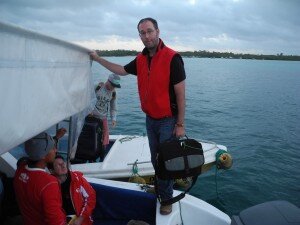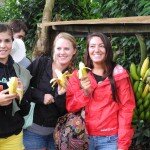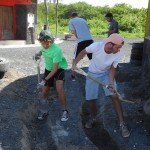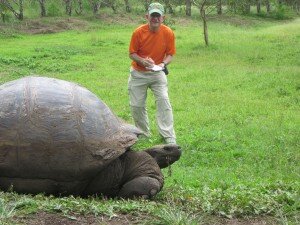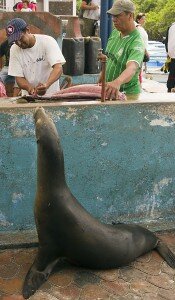Experiential Learning: The Culture and Environment of the Galapagos, Reporting, Writing, Multimedia Sound Recording and Editing
We had just finished lunch at a small restaurant in the Galapagos Islands and were walking down the main street when we saw a sea lion tottering on two flippers on the worn cement apron of an open air fish market.
The sea lion, dark brown and rising less than waist-high to the people gathered at the market, was a regular visitor. Along with a couple of scruffy pelicans, the rather elegant sea lion counted on bloody scraps of cut-up wahoo and snapper for afternoon meals.
Our group from the University of Miami was spending a little more than two weeks in the Galapagos Islands, a territory of Ecuador out in the Pacific Ocean on the equator, 600 miles from the mainland.
Charles Darwin did some of his most important work in developing his theories of evolution in the Galapagos and we were walking around in his footsteps. We climbed a volcano, swam with sea lions and penguins and explored an abandoned penal colony. We followed the migration of giant Galapagos tortoises, got within inches of blue-footed boobies and prehistoric-looking marine iguanas and got to know a lot of people who live and work in the Galapagos.
Our program embodies the concepts of experiential learning and the scholarship of teaching and learning. I and another professor teach students writing, research and critical thinking, the theory and practice of working with sound, Social Media and a range of digital editing skills. We immerse the students in the environment and culture of Latin America. What they see and experience becomes the subject material for multimedia projects designed to be published in the University of Miami’s environmental publication online, TheMiamiPlanet.org.
We take students from majors across the campus and show them how to move away from the ponderous essay style of writing that they have grown up with and begin to produce clear, straightforward material for a mass audience. What we have is an adaptation of journalism to benefit students who are preparing for a wide range of careers and most certainly will be expected to at least write effective memos and letters and be comfortable with the professional uses of Twitter, Facebook, Instagram and other Social Media and digital tools. Some of our students become markedly better writers and add to their inventory of digital skills. Others come away improved, but not great.
Our program is called The Galapagos Islands: The Environment, Culture and the Music of Darwin. Students earn six writing credits. I am responsible for CNJ 595, which deals with writing, research, critical thinking and Social Media, and my colleague, Professor Colby Leider, teaches MMI 593, how to collect and edit sound and to work with a variety of digital tools. We’ve taken as few as half a dozen students to the Galapagos and as many as 17.
Living the Learning
We work without classrooms. We have morning meetings on the beaches, on the sides of volcanos, in town squares and in cafes and hotel verandas. Professor Leider is the director of Music Engineering at the University of Miami with degrees from Dartmouth and Princeton. I am a professor of journalism at the School of Communication. I worked for more than 30 years as a reporter and foreign correspondent at The New York Times and joined the University of Miami in 2008 for a five-year assignment as the Knight Chair in Cross-Cultural Communication. I made my first trip to the Galapagos nearly 20 years ago.
Professor Leider and I give short lectures on skills and techniques and on the environment and culture of the Galapagos.
Our teaching in the Galapagos seemed a natural fit for experiential learning, defined by Kolb as “the process whereby knowledge is created through a transfer of experience” (Kolb, 1984).
“Knowledge,” he wrote, “results from the combination of grasping and transforming experience.” (Kolb, 1984) James W. Gentry concluded that experiential learning is participative, interactive and applied. “It allows contact with the environment and exposure to processes that are highly variable and uncertain,” he said. “It involves the whole person: learning takes place on the affective and behavioral dimensions as well as on the cognitive dimension.” (Gentry, 1990)
In a synthesis of work on experiential learning, researchers at Case Western Reserve in Cleveland noted that experiential learning has its roots in Dewey’s philosophical pragmatism, Lewin’s social psychology and Piaget’s cognitive-developmental genetic epistemology (Kolb, Boyatzis & Mainemelis, 1999).
Gentry cited Dewey in a 1915 work as using the term, “learning by doing.” Gentry said that Wolfe and Byrne wrote in 1975 of “experience-based learning.” (Gentry, 1990).
The Case Western researchers contrasted experiential learning with abstract conceptualism. “Some of us perceive new information through experiencing concrete, tangible, felt qualities of the world, relying on our senses and immersing ourselves in concrete reality,” the researchers wrote. “Others tend to perceive, grasp or take hold of new information through symbolic representation or abstract conceptualization—thinking about, analyzing or systematically planning rather than using senses as a guide.” (Kolb, Boyatzis & Mainemelis, 1999)
In our Galapagos program we try to capitalize on both kinds of learning. Before leaving for the islands we conduct workshops in Miami. We require students to read several books and to conduct extensive Internet research on themes that they will be developing in the Galapagos. In the Galapagos, the work is almost entirely hands-on and is informed by the abstract conceptualization in Miami.
I’ve used the experiential learning philosophy in summer abroad programs in Stockholm. Although Sweden and the Galapagos Islands are vastly different places, both are great for studying the environment and environmental practices. And the experiential philosophy can be applied.
Reflections
One feature of the tradition of experiential learning is regular reflection sessions in which students talk about what they are seeing and experiencing. In our case, they bounce thoughts and observations off others in the group and look to the others for elaboration on their own ideas and observations.
The researchers at Case Western took note of the process. “In transforming or processing experience some of us tend to carefully watch others who are involved in the experience and reflect on what happens,” they wrote, “while others choose to jump right in and start doing things. The watchers favor reflective observation while doers favor active experimentation” (Kolb, Boyatzis & Mainemelis, 1999).
Richard Jordi writes that reflective practices can facilitate a learning dialogue between implicit embodied experience and the conceptual aspects of consciousness (Jordi, 2010). We find that the reflections deepen the experience for our students and sometimes help them make connections that they had not previously recognized.
Our program is a collaboration between the School of Communication and the School of Music. It has taken more compromise than we expected. At first we gave separate lectures and expected that the overarching ideas of the environment and the culture of the Galapagos would unify the program. But that didn’t work. To give students a coherent program that did not pull them in different directions, we had to agree on a common theme and focus our assignments on making one joint multimedia product. We’ve cut back on field trips and writing and recording assignments to help our students focus and to give them more time to write, research, edit and explore on their own.
Professor Leider brings some special equipment to the Galapagos. But most of our work is done on programs that each student brings in his or her laptop. “Ten years ago,” Professor Leider says, “you couldn’t do this class in the Galapagos. You just wouldn’t have had the tools. Now everything can be done on a laptop.”
One way to understand our work in the Galapagos is through the five-point prism conceived of by Lee S. Shulman (1998), president emeritus of the Carnegie Foundation for the Advancement of Teaching and a pioneer in the Scholarship of Teaching and Learning movement. His five elements were vision, design, interactions, outcomes and analysis. I had not been aware of Shulman’s work when I designed the Galapagos program. But when I reflect on the program, I see that it developed according to Shulman’s concept.
Collaboration Begins
Professor Joseph B . Treaster taking notes about a giant land tortoise in the Galapagos Islands. Photo by Ileana Oroza.
Professor Colby Leider on a boat in the Galapagos. Photo by Joseph B. Treaster.
I had a vision that the Galapagos would be a wonderful place for our Miami students to learn about the global environment and the culture of Latin America and to improve their skills in writing, research and analytical thinking. After a summer of teaching in the Galapagos program on my own, I linked up with Professor Leider. In our joint vision the Galapagos and its environment and culture became the platform for a multimedia program combining my work in writing, research and analytical thinking with Professor Leider’s digital skills and expertise in acoustic ecology. We came together, at first, because of our research on the environment.
We’ve designed a comprehensive itinerary and syllabus. As we began interacting with students, our design began changing, as I think Shulman would have foreseen. The changes are producing better outcomes: more effective writing and better work with sound. Analysis is a daily part of our program. When we’re back in Miami Professor Leider and I keep talking, analyzing and making changes.
We work closely with the students. We start with the fundamentals and then work through the students’ drafts on projects focused on some aspect of the Galapagos, perhaps a look at a small hospital or the struggle of a certain species or maybe what it’s like to run a restaurant in the Galapagos. Everyone carries a writer’s journal and writes at least 500 words a day on observations, impressions—thoughts that might eventually find their way into the main project.
Professor Leider works with the students in winnowing down the best of their sound. We stress simplicity and clarity. I quote Elmore Leonard, the popular writer who died in 2013 with a couple dozen novels to his credit. “If it sounds like writing,” Leonard said, “I rewrite it.” Every three or four days we review the writer’s journals and give feedback.
Gentry notes that experiences occurring without guidance and adequate academic preparation may yield little insight into the general processing taking place (Gentry, 1990). For the summer of 2014 we are preparing for the Galapagos with three workshops in Miami of two hours each. In the first two-hour workshop students pick a research theme and work out a plan of execution with me and Professor Leider. Professor Leider shows them how to use the H2 Zoom digital recorder and assigns them practice exercises due at the next workshop. He introduces students to the digital sound editing program, Audacity. In the second session the students bring in outlines for their projects, a draft of 400 words of background material and their recording exercises. Professor Leider and I edit the work and the students come to the last workshop with revisions.
The reading list for our program begins with Charles Darwin, a rare scientist with a flair for compelling writing. We read The Origin of Species, his pioneering work on evolution, and the Voyage of the Beagle, the vivid memoir of his five-year sailing ship journey around South America and through the Pacific that gave him several weeks in the Galapagos. For a sense of the contemporary Galapagos we read Galapagos at the Crossroads, by Carol Ann Bassett, and for an understanding of acoustic ecology, The Soundscape, by R.Murray Schafer and The Great Animal Orchestra: Finding the Origins of Music in the World’s Wild Places, by Bernie Krause. Students are required to bring laptop computers, cameras and the H2 Zoom recorder. Internet service is uneven in the Galapagos. But, with a little patience, we can use it for research. Instead of emailing articles back and forth we transfer copy with USB memory sticks.
Professor Leider and I screen the students in separate interviews. We tell the students that we expect the experience to be fun, but that it is not a vacation. We tell them that we expect good behavior and full participation. Before we leave Miami, they sign a pledge to live up to expectations. We make clear that we are going into the developing world and that daily life does not always unfold according to plan. Our students need to be able to tolerate unexpected change. They need to be in good enough shape to hike 10 miles up and down a volcano and bike for several miles and, of course, they need to be able to swim.
We know from the work of many researchers that study abroad has an enormous impact on students (Carlson & Widaman, 1988; Bates, 1997; Ybarra, 1997; & Zhai, 2000). The researchers have found that study abroad students grow intellectually and personally and often begin a life-long interest in global affairs. One of the most comprehensive studies was carried out by IES Abroad, a non-profit organization in Chicago that conducts study abroad programs and provides logistical support for faculty-led programs. It surveyed students in a longitudinal study that ran for nearly 50 years, ending in 1999. Many of the 3,400 students in the study said that overseas study had been a defining moment in their lives. Ninety-eight percent said that study abroad helped them better understand their own cultural values. Eighty-two percent said it helped them develop a more sophisticated way of looking at the world. Eight-seven percent said that study abroad influenced their later educational experiences. Lee, Therriault and Linderholm (2012) found that students who studied abroad responded to survey questions more descriptively and with more detail and humor than students who did not study abroad. Overall, the researchers said, students who studied abroad demonstrated superior creative thinking on culturally specific and domain general measurements.
Other researchers have found greater cultural proficiency, increased openness to cultural diversity and more global awareness among study abroad students. They report that study abroad students see themselves as being more approachable and open to intercultural communication. (Anderson, Lawton, Rexeisen & Hubbard, 2006). When our students recount their Galapagos experience, they talk mostly about the impact of the people, the place, the environment and the culture. They say their experiences in the Galapagos far exceed their experiences in classrooms in Miami.
Ben Tiberio, a junior at the University of Miami majoring in music, said his time with us in the Galapagos was “a magical, life-changing experience.” Tiberio, from Rochester, N.Y., went on to study abroad for a semester in Finland and traveled to half a dozen countries in Europe. The Galapagos, he said, “was kind of a stepping-stone for me.”
Megan Dettmer, a freshman in public relations from near Trenton, N.J., said her study abroad in the Galapagos “made me think more about my life plans.”
Lindsay Walker, a junior majoring in marine science, wrote about a 93-year-old survivor of a penal colony. She discovered, she said, that “asking people about their lives is not necessarily prying and that most people do want to share about themselves.”
For Daniel Landers, a 20-year-old music major from near Sarasota, Fla., the Galapagos was “a major chapter in my life.” It “helped me take the next step in becoming who I have always wanted to be.”
Inspiration in the Wild
The Galapagos is an inspiring place and the writing and critical thinking and recording can come easily. On one field trip, we came upon a shallow bay with a rock outcropping loaded with blue-footed boobies and pelicans. Carter Soso, a music major from near Oakland, Calif., who was writing about blue-footed boobies, slipped into the warm, waist-deep water in shorts and sneakers, his tape recorder and a long boom microphone held high. I went in with my camera and notebook. We were nearly on top of the blue-footed boobies and pelicans before they lifted off. The whole idea of being able to get almost within touching-distance of wild birds was exciting. “Awesome,” Soso said.
Not far from where we saw the blue-footed boobies and pelicans, we came upon a narrow stream that was flowing out of a natural spring in a patch of mangroves. We saw a cage-like trap in the stream. Later, when we were exploring the remains of an abandoned penal colony, we met some researchers from North Carolina State University. They said the trap was theirs and that they were studying red snappers in the Galapagos. One more experience. One more dimension.
Our encounter with the sea lion at the fish market was just the beginning of our Galapagos experience in 2013. We were always exploring. We ate a lot of grilled fish and chicken and the students discovered a place that made a very good American-style milk shake. When somebody scuffed a forearm or a shin, he or she got treated at a little clinic that was short on bandages and just about everything else. Sometimes the patient was sent off to buy antibiotics in a pharmacy that, itself, was not that well-stocked. Through it all we heard the stories of the people of the Galapagos, how they and their families lived, what was hard and what was not, and how their lives had changed as more and more visitors from around the world found their way to the Galapagos.
For the summer of 2014, we’ve lengthened the Galapagos program to three weeks and for the second year we’re going to the Panama Canal and spending a day in Guayaquil, the biggest city in Ecuador with more than 2 million people. Those places, together with more than two weeks in the Galapagos, give our students a good introduction to Latin America.
By February 2014, because of word-of-mouth and campus-wide advertising with email blasts, bulletin board fliers and personal appearances in classes by me and my colleague, we had received more than 60 inquiries from students and nearly 40 applications. We initially set a limit of 12 students for the program. But as demand grew we began debating whether to add a second section of 12 more students with additional faculty.
We stay in simple, inexpensive hotels that sometimes cost as little as $20 a day for a shared room. I take care of logistics for the program, lining up hotels and transportation and guides and developing an itinerary. For 2014 I was able to trim the costs for airfare, lodging, field trips, meals and boats, buses and trucks to $3,346 per student, down from about $5,700 in 2013. Tuition for six credits in the summer at the University of Miami is a little more than $10,000 and that is a barrier for some students. The university is working to expand its scholarship support for study abroad.
Our work in the Galapagos is a world apart from what we do in our classrooms in Miami, not just in distance and lifestyle but in almost every aspect. In the Galapagos we are in a different universe. We are fully engaged all the time and we cover a lot of ground. The students learn some Spanish and they learn what it is like to live in a simple concrete block house with very few possessions. All around them they see a world moving at a much slower pace than they ever imagined.
We get to know the rhythms of the students. They get to know ours. We learn what is irritating and what is encouraging and we have found that we need to handle a range of challenges that never come up in Miami. In Miami we don’t see much of the students outside our classrooms and offices. They don’t come to us at odd hours and they generally don’t seek us out when they need a doctor or help with other personal matters. Summer abroad is different. And unforgettable.
Joseph B. Treaster is a professor at the University of Miami (correspondence: treaster@miami.edu).

